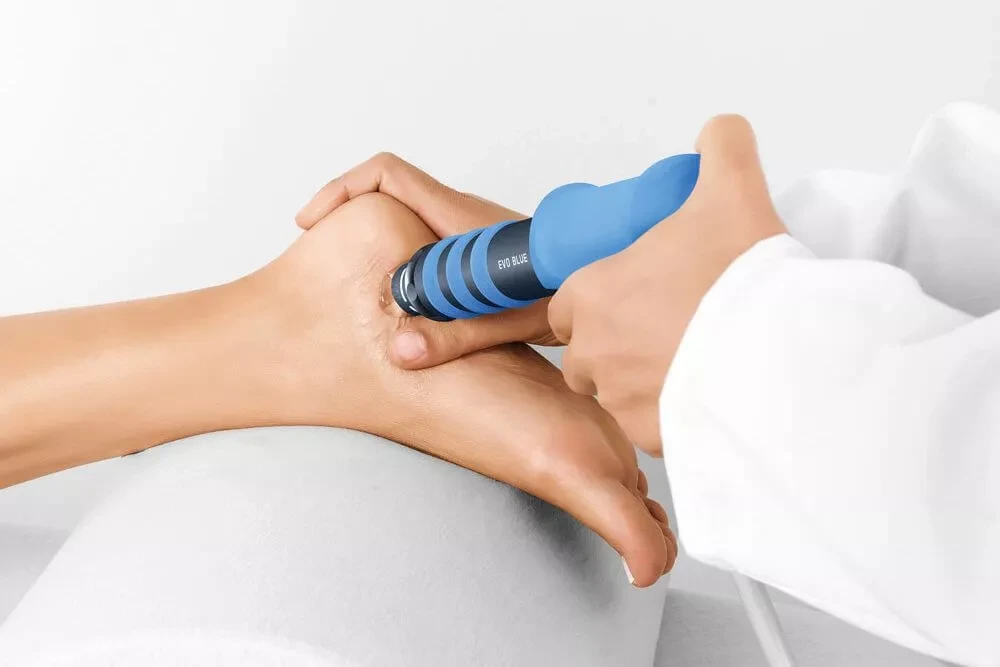

Shockwave therapy is a gold standard treatment used to help achieve the best clinical outcomes for musculoskeletal injuries and pain – and we’re very proud to now offer it to our patients here at Perform Podiatry. Shockwave has strong clinical evidence and proven efficacy across a range of pains and problems, from knee osteoarthritis to plantar fasciitis, Achilles tendinopathy, and much more. Here’s what you should know.
You may already know that there’s a great demand for shockwave therapy in Auckland at present due to the benefits it offers – but it’s actually not a “new” treatment. Shockwave has been used in medicine since back in the 1980’s, where it was used to break down kidney stones in the body. In the 1990’s, it started being used for musculoskeletal problems – in a similar way to how we use it today. Except, the shockwave machines have definitely become a lot more accessible, versatile and affordable.
Referred to as extracorporeal shockwave therapy (ESWT) in the studies (with ‘extracorporeal’ simply meaning ‘situated outside of the body’), shockwave treatment works by directing specifically calibrated, high-energy acoustic (sound) waves at a site of musculoskeletal injury, by applying the shockwave handpiece (pictured) over the damaged area, such as the heel bone or the shins. These sound waves then stimulate the body’s natural healing process in the area by increasing the blood flow locally, and stimulating the production of growth factors and stem cells that support the growth of new blood vessels and tissues to help repair the damage. Shockwave also works to reduce the inflammation markers in the targeted area, which means less pain for our clients – many of whom can feel a reduction in their symptoms after their first appointment, almost like an analgesic effect.
Our particular form of shockwave therapy is radial pressure waves (as opposed to focused waves) meaning that the radial waves spread to treat larger areas, allowing us to move the handpiece over a wider injury site instead of having to focus in on very specific locations to get the desired effects.
The benefits of shockwave include:
Based on the growing body of high level evidence that supports shockwave, it is currently being used extensively worldwide in the management of:
Before shockwave can be booked for you, your podiatrist will need to have completed an assessment so that we understand what your diagnosis is, the cause of your pain or injury, and whether or not shockwave can actually help you in your circumstances – or if there’s another treatment pathway that will be more effective in helping you get the results you want. Once we have confirmed your suitability for shockwave (and made a plan for your overall management and recovery), your shockwave session may look like:
Despite the name ‘shockwave’ making it sound like a painful course of treatment, shockwave sessions are generally well tolerated by our patients. Any discomfort or pain tends to arise from the shockwave handpiece being positioned directly over your existing injury, which is already tender. Once the acoustic waves are administered (over several ‘rounds’ at just a few minutes per round), the reparative and pain-relieving benefits begin – and being able to experience these benefits over the coming weeks is likely why our patients keep coming back, being able to see and feel their recovery process accelerated – and for many, seeing progress and results in longstanding injuries where nothing else that they have tried has really worked.
Learn more about shockwave and how it can help you here. To book an appointment, call us on (09) 523 2333 or book online here.
.png)
Since introducing shockwave therapy, we’ve helped many of our patients avoid surgery for certain conditions. Here's what you
need to know about shockwave treatment and how it works.
.png)
This Mother’s Day, consider a practical, medically safe, and confidence-boosting gift: a professional KeryFlex nail restoration treatment. It’s a simple, effective, and medically safe way to instantly transform the appearance of toenails.
Keeping your family on their feet and helping them to walk, run, play and exceed their goals is why we love getting up in the morning.
Ground Floor, One Health Building
122 Remuera Rd, Remuera
Auckland 1050, New Zealand
| MON - FRI | 7:30am – 6:30pm |
| SAT | 8:30am – 4:30pm |
| SUN | Some availability |
Make an Appointment
Online Schedule